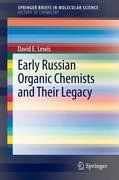
Early Russian Organic Chemists and Their Legacy
Kurzinformation
inkl. MwSt. Versandinformationen
Artikel zZt. nicht lieferbar
Artikel zZt. nicht lieferbar

Beschreibung
The organic chemists of Russia during the pre-revolutionary period included some of the most creative and talented chemists of the nineteenth and early twentieth centuries. Indeed, this is attested by the number of reactions and empirical rules bearing their names. This volume is of interest for both historians of chemistry and organic chemists wishing to discover more about the historical development of their discipline in Russia. From the founding of the Russian Academy of Sciences by Peter the Great in 1725 to the early years of the nineteenth century, Russian organic chemistry was largely in the hands of foreign scientists. However, the Russification of organic chemistry in Russia had begun before the middle of the nineteenth century, and reached its zenith during the last half of the same century, by which time vibrant schools of chemistry had arisen in the eastern city of Kazan', at Moscow and at St. Petersburg. By the end of the century, the Chairs of organic chemistry at universities throughout the Russian empire were occupied by Russian chemists, almost half of them trained at Kazan'. This volume discusses the contributions of these organic chemists which include: the structural theory of organic chemistry, empirical rules for addition and elimination, reactions involving carbon nucleophiles, such as the aldol reaction and alcohol synthesis using organozinc nucleophiles, the discovery of sulfoxides and sulfonium salts, and a range of important redox reactions. von Lewis, David
Produktdetails

So garantieren wir Dir zu jeder Zeit Premiumqualität.
Über den Autor
David E. Lewis was born and educated in South Australia, where he took a first-class degree of B.Sc. (Hons.), and a Ph.D. degree in organic chemistry from the University of Adelaide under R. A. Massy-Westropp, working in the area of natural products structure determination. After completing his Ph.D. research, Lewis moved to the United States in December, 1976. At Arkansas, he worked as Research Associate at the University of Arkansas under Leslie B. Sims and Arthur Fry, working in the area of kinetic isotope effects and physical organic chemistry. Two years later, he was appointed as Lecturer in Chemistry at Arkansas. In 1980, he moved to the University of Illinois at Urbana-Champaign as Visiting Assistant Professor, working with Kenneth L. Rinehart, Jr., in the area of organic synthesis. In 1981, he moved to his first tenure-track position as Assistant Professor of Chemistry at Baylor University in Waco, Texas; he was promoted to Associate Professor in 1988. In 1989, he moved to South Dakota State University, in Brookings, South Dakota, as Associate Professor of Chemistry; he was promoted to Professor of Chemistry in 1993. In 1997, he moved to the University of Wisconsin-Eau Claire as Professor and Chair of Chemistry; he stepped down as Chair in 1999. Lewis' research interests in organic synthesis may be broadly defined as applied organic chemistry, ranging from applications of fluorescent dyes in engineering and biology, to the synthesis of new compounds with potentially useful biological activity. He has had a two-decade interest in the history of organic chemistry in pre-revolutionary Russia, and it is this interest that has led to this volume. Lewis is a long-time member of the American Chemical Society, where he has served as Chair of the Division of the History of Chemistry, and is a Fellow of the Royal Australian Chemical Institute. He is the holder of 18 U.S. and international patents, and has published over 65 research articles, book chapters, and books.

- Hardcover -
- Erschienen 2005
- Wiley-VCH Verlag GmbH & Co....

- hardcover
- 612 Seiten
- Erschienen 2011
- Elsevier

- hardcover
- 1534 Seiten
- Erschienen 2011
- Academic Press

- hardcover
- 992 Seiten
- Erschienen 2020
- Wiley

- hardcover
- 992 Seiten
- Erschienen 2020
- Wiley

- hardcover
- 1392 Seiten
- Erschienen 2020
- Wiley

- hardcover
- 928 Seiten
- Erschienen 2021
- Wiley

- paperback
- 344 Seiten
- Erschienen 2004
- Springer

- Klappenbroschur
- 946 Seiten
- Erschienen 2014
- De Gruyter

- Gebunden
- 458 Seiten
- Erschienen 2008
- Wiley-VCH

- Kartoniert
- 500 Seiten
- Erschienen 2003
- John Wiley & Sons

- paperback -
- Erschienen 1994
- Thieme Medical Pub

- Gebunden
- 456 Seiten
- Erschienen 2019
- Springer

- Gebunden
- 505 Seiten
- Erschienen 2021
- Wiley-VCH

- Hardcover -
- Erschienen 2007
- Wiley-VCH

- hardcover
- 1397 Seiten
- Erschienen 2013
- Springer Spektrum

- hardcover
- 568 Seiten
- Erschienen 1999
- Wiley

- hardcover
- 736 Seiten
- Erschienen 2002
- Academic Press

- paperback
- 843 Seiten
- Erschienen 2006
- Pearson

- hardcover
- 528 Seiten
- Erschienen 1999
- Wiley


















![Grundoperationen der präparativen organischen Chemie. Eine Einführung [Unknown Binding] Grundoperationen der präparativen organischen Chemie. Eine Einführung [Unknown Binding]](https://d3k2uuz9r025mk.cloudfront.net/media/image/f5/8e/2d/1755146083_53015846216.jpg)







